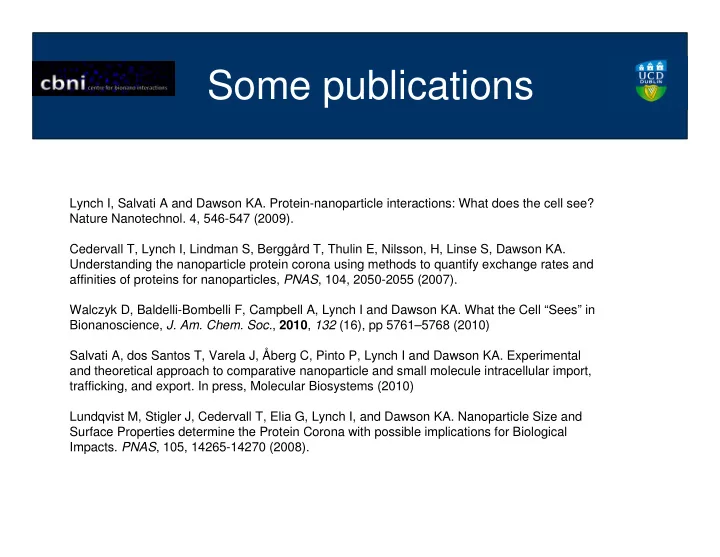

Some publications Lynch I, Salvati A and Dawson KA. Protein-nanoparticle interactions: What does the cell see? Nature Nanotechnol. 4, 546-547 (2009). Cedervall T, Lynch I, Lindman S, Berggård T, Thulin E, Nilsson, H, Linse S, Dawson KA. Understanding the nanoparticle protein corona using methods to quantify exchange rates and affinities of proteins for nanoparticles, PNAS , 104, 2050-2055 (2007). Walczyk D, Baldelli-Bombelli F, Campbell A, Lynch I and Dawson KA. What the Cell “Sees” in Bionanoscience, J. Am. Chem. Soc. , 2010 , 132 (16), pp 5761–5768 (2010) Salvati A, dos Santos T, Varela J, Åberg C, Pinto P, Lynch I and Dawson KA. Experimental and theoretical approach to comparative nanoparticle and small molecule intracellular import, trafficking, and export. In press, Molecular Biosystems (2010) Lundqvist M, Stigler J, Cedervall T, Elia G, Lynch I, and Dawson KA. Nanoparticle Size and Surface Properties determine the Protein Corona with possible implications for Biological Impacts. PNAS , 105, 14265-14270 (2008).
PEOPLE COMMUNITY RESOURCES Class III Cell Culture LOCATION FOR NEW EU INFRASTRUCTURE FOR BIONANOINTERACTIONS Students from 14 countries AND NANOSAFETY majority funds EU internationally 26 companies from around the world Cozzarelli Prize, 2008 FP RESEARCH SFI SRC, EPA, HEA http://www.cbni.eu NeuroNano Centre for BioNano Interactions IANH’
The Durable Issues Nanoparticles in contact with living matter CHEMICALS PARTITION NANOPARTICLES TAKEN UP CHEMICALS PARTITION …….NANOPARTICLES PROCESSED!
Typical quantitative Uptake Nanoparticles Non-Specialized Cells 60 ~1000 particles per cell Fold Increase Fluorescence Intensity 50 Studies finally reproducible 100nm December 1 40 proportional to nanoparticles in cell 100nm November 20 •Uptake Energy Dependent 30 50nm November 11 20 •Via endogenous pathways 10 0 •Apparent due to cell division 0 500 1000 1500 2000 2500 3000 3500 in cell lines. Time (min) 1.2 Exocytosis following 17 hr Endocytosis 1 Fold Decrease Fluorescence (25ug/ml) •No Cell level clearance 0.8 (without exit signal or 0.6 50nm Exocytosis degradation) 100nm Exo 0.4 •Accumulation in lysosomes 0.2 •SiO2 Particles (50, 100nm)* 0 0 200 400 600 800 1000 1200 1400 1600 1800 •A549 lung epithelial cell line Time (min)
New tools give unprecedented Assurance of outcomes Many surprises to come 40nm ps
THE CELL (BARRIER ETC) SEES ONLY THE SURFACE-BARE SURFACE IS ‘IRRELEVANT’ Cozzarelli PNAS, 2007, 104, 2050-2055 Prize NAS NATURE NANO, 2009, 4, 546 2008 JACS, 2010
Dramatic effects from adsorbed proteins Medical Devices vs. protein-drug associations? 50nm SF 100nm SF No protein present amount of nanoparticles in cell 50nm CMEM 1200 1200 1200 1200 100nm CMEM Signal proportional to PROTEIN ABSENT Fold increase in fluorescence 900 900 900 900 600 600 600 600 300 300 300 300 PROTEIN PRESENT 0 0 0 0 0 0 0 0 2 2 2 2 4 4 4 4 6 6 6 6 Time (hours) CORONA IS ALWAYS WHAT CELLS/BARRIERS ‘SEE’?
Characterization in Blood (or appropritate Biomedical medium) will be the foundation of all in future Targeting, immune response etc nanoparticle complexes in situ are essentially the same as when isolated Bare particles in PBS 100 B 1h 100 1h A 6h X 6h X 80 Particles in plasma Corona shell 80 … Rel. M w Rel. M w 60 60 40 40 Ps, 100nm 20 20 0 0 0.1 0.2 0.3 0.4 0.5 0.6 0.7 0.8 0.1 0.2 0.3 0.4 0.5 0.6 0.7 0.8 particle diameter, µ m particle diameter, µ m Plasma background Washed sample, re-suspended
Quantitative Analysis of Corona Identity now Possible;implications profound Densitometry of SDS-Page Gel • Trypsin digestion, peptide extraction and purification on gel slices • Reverse phase HPLC- MS/MS to ID In vitro level, 10% s.c. = serum concentration
Even the Simplest Materials Can Adopt Unforseen Biological identities In presence of Plasma (CSF, etc ) Protein Array Map in plasma PS-OSO 3 5mg/ml PS-OSO 3 in 10% plasma 5mg/ml PS-OSO 3 PS-OSO 3 10% plasma A1 A2 A3 T1 MWL HSA TR T2 T3 outer dense fiber of sperm tails 2 Block 36 PS-OSO 3 5 µ g/ml PS-OSO 3 in 10% plasma 5 µ g/ml Very wide range of plasma binding profiles Depending on grafted protein and means by which it was grafted Multimeric-protein corona assemblies display different interaction pattern than bare NPs- includes functionalized NP’s.
Inconsistent Literature? In vitro and in vivo comparison New Tools Case study of Transferrin Transferrin (Tf) has target Transferrin receptor (TfR) carries iron into cell Rapidly dividing tumour cells have need for extra iron (haem) and cells have overexpressed TfR
The Complex Role of Multivalency in Nanoparticles Targeting the Transferrin Receptor for Cancer Therapies Wang et al, J. AM. CHEM. SOC. 2010 , 132 , 11306–11313 Uptake of X-grafted particles Viability of Cells (Toxicity) (200nm print) Human transferrin Bovine transferrin antibodies Anomalous toxicity NP-hTf Ramos NP-hTf particles taken up Co-stain acid Unchanged with added iron (lysotracker) non Lysosomal not iron sponge
Mechanism of active targeting in solid tumors with transferrin-containing gold nanoparticles Choi et al PNAS January 19, 107, 1235–1240 (2010) Typical, 25-40% res <5% Tumor Gold PEG 144 per particle •24 hours after i.v. tail injection mic with Neuro2A tumours •Targeting does not change the bulk balance of particles in organs (or tumour) •Most goes to RES (many in Kupfer cells of liver) •Within organs uptake of particles in Tf rich cells (eg Tumour) threshold 144
COMMUNICATING WITH THE MACHINERY OF THE CELL-THE REAL INTERFACE
GRAFTING OF PROTEINS, ORIENTATION, DISRUPTION INTERACTION WITH PROTEINS OF ENVIRONMENT ?
Silencing Transferrin receptor For Many Examples cited in literature, Silencing pathway does not stop their uptake Are we REALLY seeing simple Targetting O OH O Red: TFR Green: transferrin N O H OH Binding Transferrin on NPs Transferrin and TFR in Neg siRNA treated cells Very strong decrease in Tf uptake Transferrin and TFR in TFR siRNA treated cells
Some Messages •NEW METHODS OF IN-CELL, IN VIVO IMAGING CRITICAL FOR NANOMEDICINES(OLDER ESTABLISHED METHODS ICPMS ETC UNSUITED) •CHARACTERIZATION IN SITU IN BIOMEDICAL CONTEXT-NEW METHODS, PROTEOMICS BROADLY DEFINED •RADICAL RE-THINK OF TARGETING, WHAT IS HAPPENING, AND WHAT WILL BE REQUIRED FOR DURABLE AND SAFE APPLICATION- ENGINEER THE INTERFACE, DON’T GUESS!
Recommend
More recommend